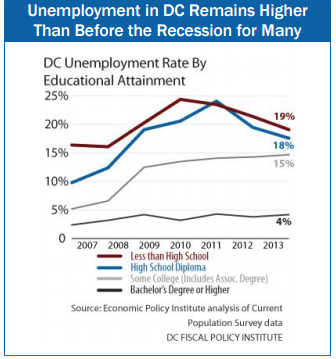A DC Council hearing held on Thursday served as an important reminder that DC should do more to help unemployed and underemployed residents get good jobs. In particular, the District needs to move forward more assertively to develop a new plan for its education and training systems, as required under a recent federal law.
The subject of the hearing, the “Unemployment Profile Act of 2015,” would require the Department of Employment Services (DOES) to conduct a profile of unemployed and underemployed District residents in order to gain a better understanding of their specific educational and training needs. The idea is that they would then be offered training programs to be better matched with available jobs in the city.
The hearing emphasized the fact that unemployment in the District remains a big problem. DC’s overall unemployment rate — 7.5 percent in April 2015 — has fallen in recent years but still has not fully recovered from the Great Recession; unemployment was under 6 percent in 2007. Many DC residents continue to face difficulty finding work, especially those who are:
 Without a college degree. Nearly 20 percent of residents without a high school diploma, and 18 percent of those with a high school diploma, were unemployed in 2013, compared with just 4 percent of those with a college degree.
Without a college degree. Nearly 20 percent of residents without a high school diploma, and 18 percent of those with a high school diploma, were unemployed in 2013, compared with just 4 percent of those with a college degree.- Black. With an unemployment rate of 16 percent in 2013, Black residents are four times as likely as white residents to be unemployed.
- Younger. The unemployment rate for those aged 16-24 was nearly 15 percent in 2014, higher than that of any other age group.
The Unemployment Profile Act calls for individualized assessments of an unemployed resident’s educational and training needs. It also calls for training to be tailored to jobs that will be available in the future, based on economic outlook projections and specific development projects approved by the city.
Those are efforts that the District is supposed to be making anyway, as a result of a recent federal law, the Workforce Innovation and Opportunity Act (WIOA). Yet it is not clear that sufficient progress is being made, even though a WIOA plan is due next March. WIOA encourages a new focus on low-level literacy training, programs that help people earn money while in training, better outcomes and performance measurement systems, as well as a “career pathways” approach. A career pathways approach allows people to enter at any point in the educational/training spectrum (from those needing literacy to those needing hard skills training) and also facilitates transitions from one level to the next.
While the District created a Career Pathways Task Force even before the passing of WIOA, the task force and broader WIOA planning has been slow-going. With the March deadline fast approaching, an increased emphasis should be given to developing a solid, workable plan based on practices that have proven to work best. This would help all workers in the District achieve the education and job training skills they need to gain meaningful employment.
To print a copy of today’s blog, click here.
